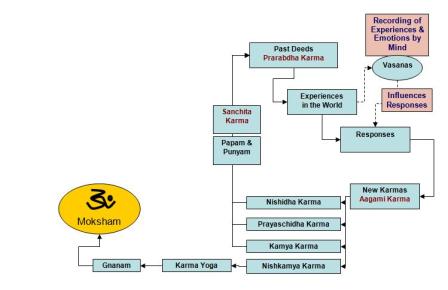Even though the very objective of the birth is to exhaust the past Karmas, we end up doing new Karmas thereby creating a Karma Cycle. From the stand point of the current birth, The past deeds (Prarabdha Karma) determine the environment responsible for the current experiences in the world. The experience create the Vasanas which are the recorded version of the Experiences and the Emotions. They influence the responses to the experiences. The Responses create new Karmas (Aagami Karma) which add on the pool of Karmas (Sanchita Karma). A portion of the Sanchitha Karma matures in the next birth as Prarabdha Karma.

Karma Cycle
The Karmas we do can be classified as:
- Nishidha Karma – Those that are prohibited by Shastras and to be avoided totally.
- Prayaschidha Karma – Those that are performed as remedy to the past Karmas. Annual upakarma and Dosha Nivirthi Karmas are examples.
- Kamya Karma – All those acts performed with a desire fall under this category. Shastra allow Kamya karmas with moderation. The desire can pertain to this world or other world. Acts seeking higher worlds are also part of Kamya karmas.
- Nishkamya Karma – The acts performed without a desire fall under this category. The acts are performed as prescribed in the Shastras without seeking the fruit of them actually provide a higher benefit of chitta shuddhi (Purity of mind).
Nishkamya karmas become the karma yoga and combined with self knowledge becomes Moksham or Jeevan Mukthi. The karmas drop out as the duality is lost for a realized person. The doer and the beneficiary do not exist and hence has nothing to be done. Karma’s can never be given up. It has to be done either as you duty till realisation or as Loka Sankraham (Social cause) after self realization. However Karmas drop out of the realized person with the destruction of their ego.
Sareera Cycle as a consequence of Karma Cycle

Sareera Cycle
Birth cycle continues for an unrealised person. Once the prarabdha karma at the time of birth and that portion of the Aagami Karma for the current life are exhausted, the stula sareera perishes. However the Sukshma Sarrera continue with the balance Aagami and Sanchita Karma to take a new body by allocating a portion as Prarabdha for that life. This continues till the end of the creation (Pralaya), when the Sukshma Sarrera also perishes with the Stula Sareera then to become the Karana Sarrera. Balance Karmas stay with the Karana Sareera till the next creation, when it takes a new Sukshma Sareera and Stula Sareera. The cycle is only broken by the realisation where the Gnani is detached from the Karmas and hence the need for a body or birth.
We have come a long way starting from the fundamentals of our Religion to the understanding of the Maha Vakya eventhough what we have gained is just the basics of Vedanta. To progress in this path of realisation we need the directions of a Sath Guru. Contrary to our common belief Guru is not a personality but a principle.